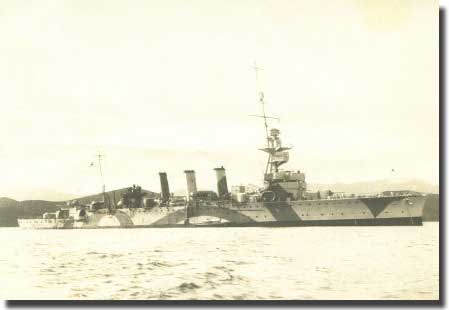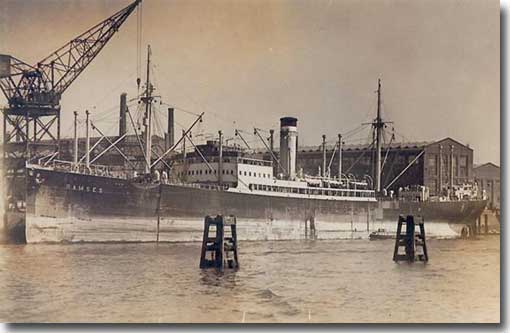|
Blockade Runner Ramses
(See more in letters and see a personal account of a Ramses crew member) After being sunk whilst serving in HMAS Canberra on the night of the 9th. of August 1942, I took several weeks to return from the scene of this battle in the Solomon Islands back to Australia. Two weeks survivor's leave mostly taken up by rekitting my uniforms followed, ( I had leapt off the Canberra's burning upper deck onto the US destroyer Blue, clad only in a pair of overalls, socks and my boots, all my belongings going down with my ship) then I was appointed as a Watch Keeping Sub Lieutenant to the old light cruiser HMAS Adelaide, working in the Indian Ocean on escort work out of Fremantle in Western Australia.
HMAS Adelaide involved in the action against the German Blockade Runner Ramses I had not long settled into my new ship, when, on the 23rd. of November 1942, we sailed in company with the Dutch light cruiser Heemskerck, and three Merchant ships, all loaded with oil drilling equipment bound for Abadan. Two days out, we were joined by the Tanker Goldmouth and HMA Corvettes, Cessnock and Toowoomba. To further set this scene I need to go back in time to prewar, then onwards to the time under review. The German motor vessel Ramses of 7,983 tons with a top speed of only 12 knots had been built in 1926, and left Hamburg on the 1st. of July, 1939 for Shanghai, where she arrived on the 25th. of August. With the declaration of war on the 3rd. of September 1939 - Ramses found herself stranded in the Far East, remaining at Shanghai until the 29th. of March 1941 when she sailed for Kobe in Japan.
Ramses in Japan prior to sailing as a Blockade Runner In May 1941 she left Kobe for Darien where she loaded soya beans and rubber to sail for Valpariso on the 20th. of May. However, on the 27th. of June she was ordered to turn around and make for Yokahama, arriving there on the 30th. of July, to discharge all her cargo. Ramses now remained at Yokahama, empty of any cargo, but now designated a prison ship for Allied prisoners who had been captured when their various ships had been sunk by German Armed Merchant Raiders prowling the oceans of the world. Scuttling Charges Blockade Runner Cargo At last, Farewell to Japan. After languishing in the Far East for over three years, at long last Ramses finally cleared Yokahama on the 10th. of October 1942, bound for Batavia, via Kobe and Balikpapen in Borneo. At Balikpapen, the ship off loaded about 1,000tons of mixed cargo, including building materials consisting of fire bricks, timber fabricated for huts, nails, machinery, coal tar, bleaching powder, lubricating oil, and some very important Beer. Calling at Batavia was most important - the purpose, to load 4,000 tons of rubber, this product desperately short in Germany was allocated the highest cargo priority, it was to becarried even if other cargo had to be left behind. Finally, 1,500 cases of quinine were placed on board. Destination Bordeaux, France. Ramses now sailed from Batavia on the 23rd. of November, bound for Bordeaux, the ship hoping to run the Blockade by maintaining a sharp lookout at all times. A constant lookout was set by three soldiers, and three seamen in each watch, thesewere located, one in the crow's nest, one on each wing of the bridge, one forward, one aft, with the last man kept as a spare. All lookouts were given a powerful pair of binoculars, and there was a telephonic connection to both the crow's nest and the lookout posted aft in the ship, and the helmsman always wore a telephone headset. Armament Crew Tactics The crew had been promised a new Blockade-Running Medal, struck in the form of a chain, with a picture of Bremen breaking through to destroy the chain. Action Stations aboard Adelaide By 1528 we were well placed on her beam to carry out a positive identification. Our Captain was ably assisted by Lieutenant J.W. Penney, his Navigating Officer who had served as a Mechant Navy Officer with experience of the construction details of many merchant ships. He quickly produced a photograph of the German ship Ramses from a pack of "German Armoured Merchant vessels and Merchant vessels." In all essential details this appeared to be the ship under observation, it was time for decisive action. Adelaide was 12,000 yards from Ramses, who, at this stage was flying a Norwegian Ensign. (Captain Esdaile was not going to be caught approaching this ship too close, as had done Captain Burnett in HMAS Sydney in November of 1941, to be sunk in a close encounter with the German Raider Kormoran, with the loss of Sydney's entire crew of 635 Officers and Sailors.) At 1536 Ramses was practically stopped and two boats were lowered on her port side. About eight minutes later an explosion was seen at her stern; the wind quickly blew this smoke so that it covered the whole port side, leaving only the masts and thetop of the funnel visible. Adelaide immediately opened fire, as did Heemskerck, by 1551.5 we ceased firing, and Ramses sank at 1552. The crew had abandoned ship, except for her Captain, the Officer in charge of the gun crews, and the Wireless Officer, all of whom were completing the extensive scuttling arrangements. However, hits from Adelaide's third salvo quickly hastened their departure. As Ramses slipped slipped beneath the sea, her main 6 inch armament, the wooden gun, together with its wooden platform gently floated off, and we suddenly realised just why we had not been subjected to fire from this source! Heemskerck was ordered to rejoin the convoy, whilst we busied ourselves with picking up survivors, seventy eight crew, (now prisoners of war) ten Norwegian Seamen, their ship sunk by a German Armed Merchant Raider, (now free men once more) a pig, and a dog. How ones' luck may quickly change with the vagries of war! My most vivid memory of this action, was the sight of some of our seamen who suddenly stopped hauling in German survivors, to rescue both the pig and the dog before them, indicating their priority in this rescue operation. I became most attached to this dog, but after our arrival at Fremantle, we disembarked both the Norwegians and the Germans, and Australian Quarantine Officers insisted on destroying the dog, to ensure that no disease was imported into the country. I was saddened. Conclusion
German POW"S in camp in Australia in WW2. |



